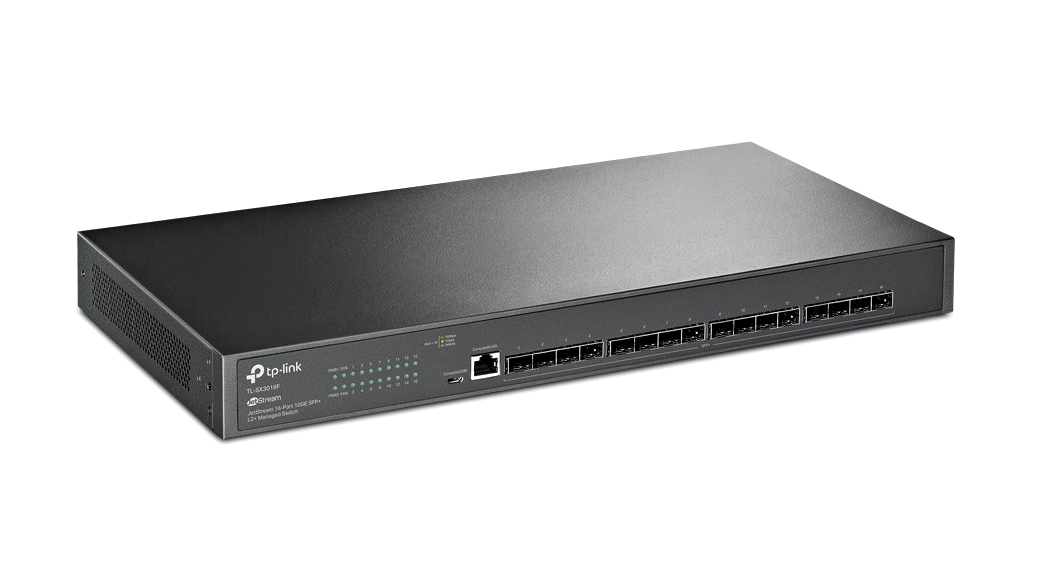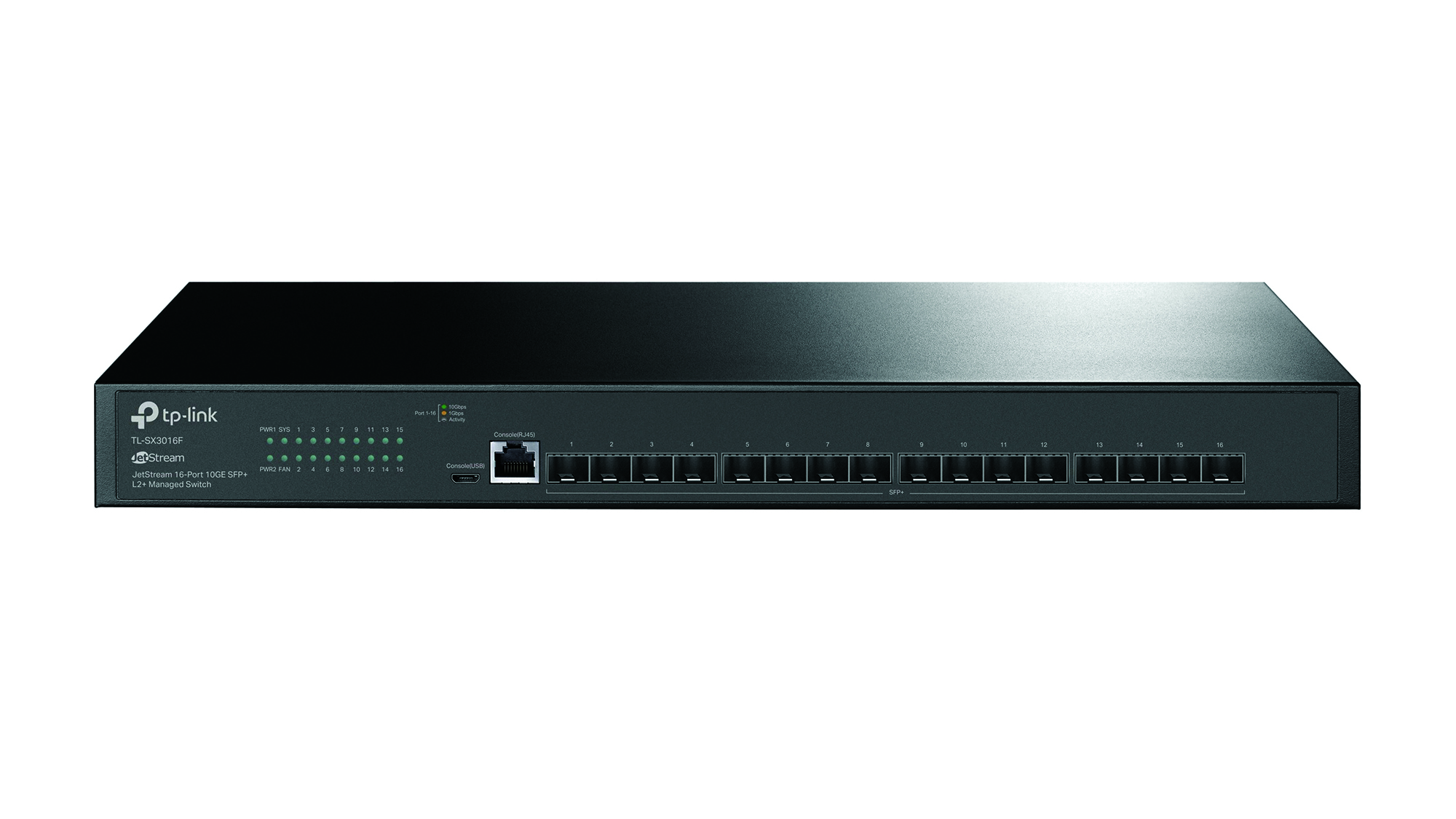TP-Link JetStream TL-SX3016F review: Plenty of ports at a pleasing price
A great-value fibre 10GbE switch with a low cost per port, high performance and plenty of features


-
+
Outstanding value
-
+
Robust management features
-
+
No restrictions on features
-
+
16 SFP+ 10GbE ports
-
-
No dynamic routing

Fibre optic 10GbE networks are becoming affordable for SMBs, and TP-Link’s TL-SX3016F switch intends to make them even more appealing. This slimline 1U chassis offers 16 SFP+ 10GbE ports for a shade over £400, to deliver an incredibly low cost per 10GbE port of only £26.
You’ll need to factor in the cost of laser transceivers and fibre optic cabling, but a big advantage over copper 10GbE installations is they support much longer distances. Furthermore, unlike blue-chips that may lock you in with their own coded transceivers, the TL-SX3016F has no restrictions and happily accepted our PlusOptic 10GBase-SR models, which cost £35 each and support connections of up to 300 metres.
The TL-SX3016F has the capacity to handle a high data throughput, as it’s endowed with a speedy 320Gbits/sec backplane. Combine this with a high 238 million packets per second (mpps) forwarding rate and you have a switch that easily has the measure of more expensive 10GbE SMB products like the Zyxel XS1930-12HP.
A feature you wouldn’t normally expect to see at this price is dual redundant power supplies. Two sockets are provided at the rear, with the first PSU acting as the primary source; if that goes down, the second PSU steps in immediately to take over.
You also get a choice of management modes. The switch offers its own web browser interface or it can be integrated into TP-Link’s Omada cloud portal. In standalone mode, the web console sensibly requests the default administrative password to be changed and then presents a dashboard view showing the status of each port.
Tabs are provided for quick access to the various functions, with the switch offering an abundance of Layer 2 (L2) features, including port, MAC and protocol-based VLANs, and QoS traffic prioritisation, plus static and LACP link aggregation groups. VoIP networks are covered as the switch identifies traffic from IP phones using their organisationally unique identifier (OUI) and automatically prioritises it by dynamically creating voice VLANs.

The switch also offers basic Layer 3 routing capabilities. Referred to as “Advanced L2+” or “Layer 3 Lite”, it supports static IPv4 and IPv6 routing, but not the dynamic routing found in more costly full Layer 3 switches.
There are some nice surprises for switch monitoring. Along with support for all versions of SNMP, the switch has an internal sFlow agent for sending packet sampling data to a collector device. We found this very useful as we pointed the agent at a host running the WhatsUp Gold 2022 network-monitoring software, which promptly started reporting back on switch port utilisation, traffic throughout, the top detected apps and all endpoint conversations.
To remotely manage the switch, you’ll need to deploy TP-Link’s cloud controller at each site. TP-Link provides free Windows and Linux software versions, but for testing we use its preconfigured Omada OC300 hardware controller which costs around £110; the smaller OC200 costs only £63.
The cloud portal lists all assigned controllers; selecting one takes you to its own web interface, which provides a central location for managing and monitoring all TP-Link switches, routers, gateways and wireless access points. New devices initially appeared in the controller’s web console as “pending”, and once we had “adopted” the switch, it disabled its local web interface and took all settings from the controller.
The portal provided plenty of information about switch operations but some features, such as L3 options and the sFlow agent, can only be configured when it’s in standalone mode. This wasn’t a problem as we set these up before adopting the switch into Omada and set the portal’s override feature so all local settings were retained.
The TL-SX3016F is a great choice for small businesses that want a high-performance fibre 10GbE core switch and larger organisations looking for a low-cost aggregation solution. It partners a big helping of SFP+ ports with a great range of features, and all at a price the competition will be hard-pushed to match.
TP-Link JetStream TL-SX3016F specifications
| Chassis | 1U rack/desktop chassis |
| Ports | 16 x 10Gigabit SFP+ slots, RJ-45 and micro-USB console ports |
| Backplane capacity | 320Gbits/sec backplane capacity |
| Total MAC addresses | 32K MAC addresses |
| PSU | Dual redundant internal PSUs |
| Management | Web browser management, Omada controller software for Windows/Linux (free download) |
| Warranty | Limited lifetime warranty |
Get the ITPro daily newsletter
Sign up today and you will receive a free copy of our Future Focus 2025 report - the leading guidance on AI, cybersecurity and other IT challenges as per 700+ senior executives
Dave is an IT consultant and freelance journalist specialising in hands-on reviews of computer networking products covering all market sectors from small businesses to enterprises. Founder of Binary Testing Ltd – the UK’s premier independent network testing laboratory - Dave has over 45 years of experience in the IT industry.
Dave has produced many thousands of in-depth business networking product reviews from his lab which have been reproduced globally. Writing for ITPro and its sister title, PC Pro, he covers all areas of business IT infrastructure, including servers, storage, network security, data protection, cloud, infrastructure and services.
-
 ‘Phishing kits are a force multiplier': Cheap cyber crime kits can be bought on the dark web for less than $25 – and experts warn it’s lowering the barrier of entry for amateur hackers
‘Phishing kits are a force multiplier': Cheap cyber crime kits can be bought on the dark web for less than $25 – and experts warn it’s lowering the barrier of entry for amateur hackersNews Research from NordVPN shows phishing kits are now widely available on the dark web and via messaging apps like Telegram, and are often selling for less than $25.
By Emma Woollacott Published
-
 Redis unveils new tools for developers working on AI applications
Redis unveils new tools for developers working on AI applicationsNews Redis has announced new tools aimed at making it easier for AI developers to build applications and optimize large language model (LLM) outputs.
By Ross Kelly Published
-
 Google layoffs continue with "hundreds" cut from Chrome, Android, and Pixel teams
Google layoffs continue with "hundreds" cut from Chrome, Android, and Pixel teamsNews The tech giant's efficiency drive enters a third year with devices teams the latest target
By Bobby Hellard Published